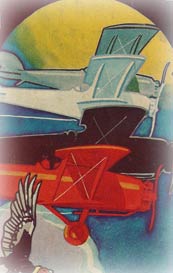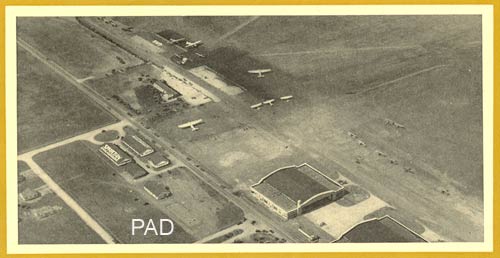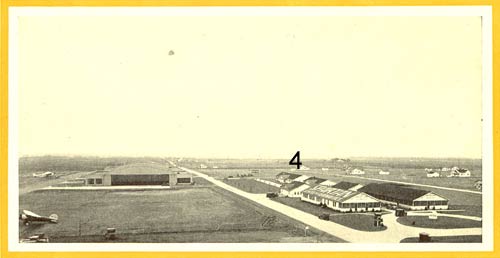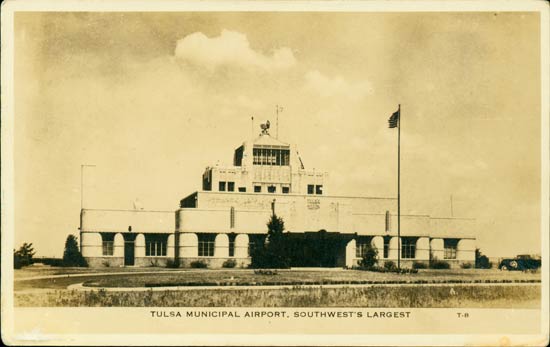|
We are fortunate to have for this airport two images, taken
from almost the same vantage point, just three years apart.
The image below is from 1930. Notice that "SPARTAN" is
painted on the smaller buildings at left. The Tulsa Airport
was home base for the Spartan School of Aeronautics. See
this download (PDF
file scanned at 300dpi, 6.96MB) for the school's advertising
brochure and tri-fold pamphlet.
In this image, nothing is painted on the hangars at the
bottom right. Note also the small backward "L"-shaped
building left center, which looks like it is situated on
a plot of land that is under development. There is a rectangular foundation
that I marked "PAD" toward
the bottom of the image.
Below is an image from 1933. "SPARTAN" is still
on the smaller buildings, but it is now also painted on the
larger hangar, bottom right. Notice also that the small "L"-shaped
building has been replaced with a larger, marked "NEW", multi-story
building. And the rectangular "pad" has the fourth structure
erected on it. Notice also that "TULSA" has been chalked
in with a directional arrow in the clear area just above
the cluster of small buildings. There is also a new asphalt
N/S runway and apron.
 |
Given these images, the image below, also dated 1930, must
have been taken sometime after the one at the top of this
page. Notice that the new small building, marked "4" can
be seen just beyond the third one. The perspective of the
photo also looks like it might have been taken from the roof
of the new multi-story building, which is probably the pilot quarters building pictured at Mr. Cooper's Collection home page (link, left sidebar). There is what looks to be a nice new Lockheed Vega lower
left.
Below, a postcard of the era. Compare the layout of this aerial image with that of the ones above. The development and population of buildings appears more advanced than above.
Tulsa Municipal Airport Postcard, Date Unknown
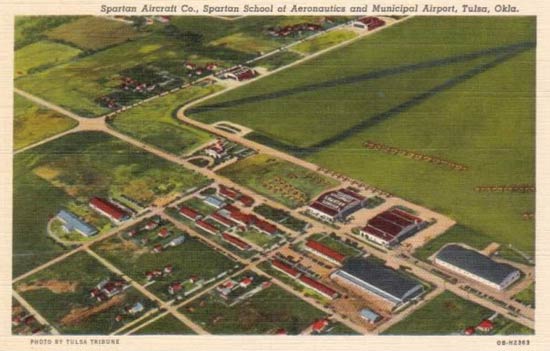 |
Below, an image of the terminal building shared with us by Tim Kalina. He says about the image, "No date on the card but, judging by the car, the date may be the late 1920s or early 1930s." The date is probably between 1930 and 1933 (compare the first two images on the page, above). You can see motion picture footage of the terminal building in the YouTube video at the link. The film is from early in WWII. Note: As of 05/16/16 this film was not available on YouTube and I couldn't find it with a search. If you can find it, please let me KNOW and I'll re-establish the link.
The airfield of the 1930s was located six miles northeast
of the city of Tulsa, one-half mile southeast of what was
then called Mohawk Lake. It was 420 acres of sod at 665'
MSL. It had "Tulsa Municipal Airport" written on the top
of a hangar (far hangar in the 1933 image).
It had one asphalt runway of 2,175', but the entire field
was usable for landing. It had the standard green/white flashing
beacon and flood/obstruction lights for nighttime orientation.
For communication the airport had a telephone, a Department
of Commerce two-way radio on 298Kc, and teletype. Weather
reports were available at the field.
Bus transport was available to the city and overnight accomodations
were there. A restaurant was at the airfield, as were fuel,
oil, aircraft storage and 24 hour maintenance. There were
no landing or flood light fees. The Spartan School was across
from the airport.
Today, KTUL is still in the same general area. Direct your
Google Earth viewer to 36 degrees 11 minutes 53.91 seconds
N and 95 degrees 53 minutes 17.91 seconds W. The city of
Tulsa has sprawled out to the northeast to catch up with
the airport. The
lake is now in Mohawk Park, and called Yahola Lake.
---o0o---
WHAT WAS IT LIKE INSIDE THE TERMINAL BUILDING?
Please see the credits in the right sidebar for use of the six images below. Charles W. Short, Jr. (not a signer of the Register, but he rubbed elbows with many of our pilots) was the manager of the Tulsa Municipal Airport from 1929 to 1955. Through his 26-year tenure, he collected an historic group of photographs of important aviators, movie stars, celebrities, airplanes and aviation-related entities. His business card is below, photograph courtesy of Kevin Gray, frequent site visitor and Tulsa airport historian.
Charles W. Short, Jr. Business Card, Date Unknown (Source: Gray)
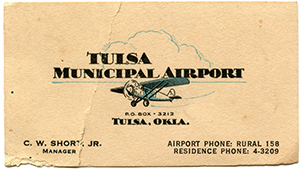 |
We have six photographs of the inside of his office at the airport in what appears to be the building marked "NEW" in the image above (the terminal building in 1933). We can date the images below, because there is a calendar visible in IMAGE 5, dated November, 1944. Further, it was about 2:00PM.
Following the display of the individual images, there is a choice table below them that allows you to download a 400dpi copy of each photograph should you want to explore the photos on the back walls, and the artifacts around the room, more closely in your image browser or photo management software. I encourage you to do that, as this is a VERY interesting room. The six images take us on a clockwise tour of Short's office. From a spot in front of his desk, below, we turn about 60 degrees clockwise to snap each successive image.
Below, is IMAGE 1. It is difficult to tell the compass direction out the window, but it is reasonable to guess it is probably northwesterly, overlooking the ramp and runways. Likewise, it is hard to say whether his office is on the second floor, as suggested by one of the news articles linked from the left sidebar, or on the first floor.
Partly because of flash glare, it is not possible to identify the building(s) visible in the distance through the window at left. However, with a little help from PhotoShop, there does appear to be a conventional gear airplane parked and facing us through the left-hand window, with at least one building well-behind it. This would agree with the ground geometry of the 1933 image, above.
Charles Short at his Desk, ca. 1944
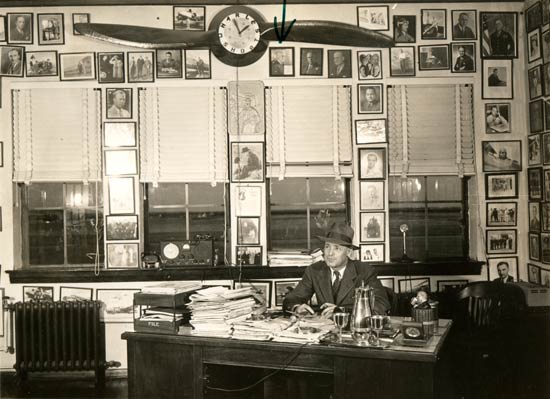 |
Note the image of Walter Beech, second row, at upper left, and the propeller with numerals replaced with the 12 letters of Short's name. There is a radio set sitting on the window sill with binoculars on top of it. A microphone sits on the sill at right. His desk appears mounted with work, leaving little room for the cigar humidor, clock and silver "water" set in the right foreground. Short holds a cigar in his left hand. If you download the high-resolution images from the table below and can recognize other people, aircraft or events in the photographs, please let me KNOW.
Below, is IMAGE 2. Clarence Tinker is identifiable at left center; two images of Hap Arnold at dead center; young Presidents Coolidge (third down) and Roosevelt (tenth down) in the 5th column from the left. Larry Fritz (?) and Amelia Earhart are below Coolidge.
Office View, Right, Rear
 |
Wiley Post and the "Winnie Mae" are at far right, just over the door. The wings insignia on the door is the emblem for the "secret" pilot organization called the "Quiet Birdmen" (QB). On the desk we see his telephone with a silver-rimmed crystal tobacco pipe holder behind it. To the lower left of the document tray, the compulsory piston ash tray with a cigar lying across it.
Below, is IMAGE 3. The perspective of this image is still from in front of the desk, but we have turned another 60-degrees to view the front corner of Short's office.
Office View, Right, Front
 |
Models of the "Winnie Mae" (NC105W) and a Lockheed P-38 hang at upper right. At upper left on the wall we see Will Rogers and Roscoe Turner. We see actors James Cagney and Tyrone Power near top center, with Eddie Cantor two rows below Power. Tyrone Power, himself a pilot, flew around the world with Register pilot Bob Buck. This adventure is described in Buck's book. At bottom left we see Larry Fritz (again) and, fourth over from the bottom left, a young Jack Frye in profile.
Two books arrayed on the top of the filing cabinet are noteworthy. Franks Hawks' "Speed" is at left. The original book, published in 1931, had a red cover with black printing. Note also a book of poetry by James Whitcomb Riley (right), "Riley Songs o' Cheer". Although Riley barely overlapped with the age of flight (he died in 1916), his lines sometimes could be interpreted as the experience of pilots, to wit:
- "While birds in scattered flight are blown
- Aloft and lost in dusky mist,
- And truant boys scud home alone
- 'Neath skies of gold and amethyst;
- While twilight falls, and Echo calls
- Across the haunted atmosphere,
- With low, sweet laughs at intervals,--
- So reigns the rapture of the year."
|
Below, is IMAGE 4. The perspective is with our back to the desk in IMAGE 1. Three models, the P-38, the "Winnie Mae" and what looks like one of the Grumman "Cats" hang from the ceiling. A group shot of Wiley Post, Charles Lindbergh, and an unidentified gentleman is above the right wing of the "Winnie Mae".
On the windowsill are what appear to be 50 caliber cartridges, a small globe as well as a flat cardboard chart of the Pacific Ocean supported by two figures, and black rubber airplane silhouette models. On the wall at lower right, just above the chair arm, is what appears to be a photograph of the Hughes Racer.
Office View, Opposite Wall

|
If you download IMAGE 4 and look along the left-hand edge, two pictures up from the stack of books, you'll see kind of a surreal item. It is a picture of a military-uniformed person with another gentleman (perhaps Short), standing in front of the photo wall in Short's office pictured in IMAGE 3, above. A photo within a photo, as it were. See if you agree.
Notice the clock in the center of the propeller near the floor. Either this photo shoot lasted almost three hours, one or both of the clocks was not working, or the images were taken on separate days. The darkness out the window at 4:40 PM on that November day may be consistent with any of these possibilities.
Below, is IMAGE 5. The orientation is 60 degrees to the right of the one above. Jimmy Doolittle, Will Rogers and Charles Lindbergh are identifiable in the large images at top right, as is the model of the "Winnie Mae". Down the right side of the door is a 3x6 array of mostly WWII military aircraft.
Office View, Left, Front
 |
On the door is the calendar from November 1944 that dates this photograph series. At lower left is a Curtiss Pusher, probably flown by either Al Wilson or Billy Parker, both known for their Pusher replicas. The Item on the tripod is a QB artifact.
Below, is IMAGE 6. We have come full-circle. Note the radiator position in this photograph and compare it to IMAGE 1, above. You can just see the piston ashtray with cigar at lower left. Mr. Nichols says about this photo, "Along the right side, half way up, there is a picture with 9 portraits in ellipses. This is of the original founders of the airport." In the upper left corner appears Ruth Nichols in front of a Lockheed Vega. Two images below her shows Charlie Short on the telephone behind the goblets on his desk. The long photo at image center appears to be a group of people posed with a hangar building in the background. Compare this with the 1930 images at the top of this page.
Office View, Left, Rear
 |
In the first row up from the bottom, two from the left, is what appears to be the "Winnie Mae" on the ground surrounded by a crowd of people. At bottom center is another nested image of someone standing in front of the photo wall in IMAGE 3. Eddie Cantor is just behind his left shoulder. Note the radio set on the window sill at right with the ground wire (?) going to the radiator.
---o0o---
Below, a Christmas greeting card shared by site visitor Kevin Gray. Don't try this at home.
Circa 1940s Tulsa Municipal Airport Christmas Greeting Card, Front
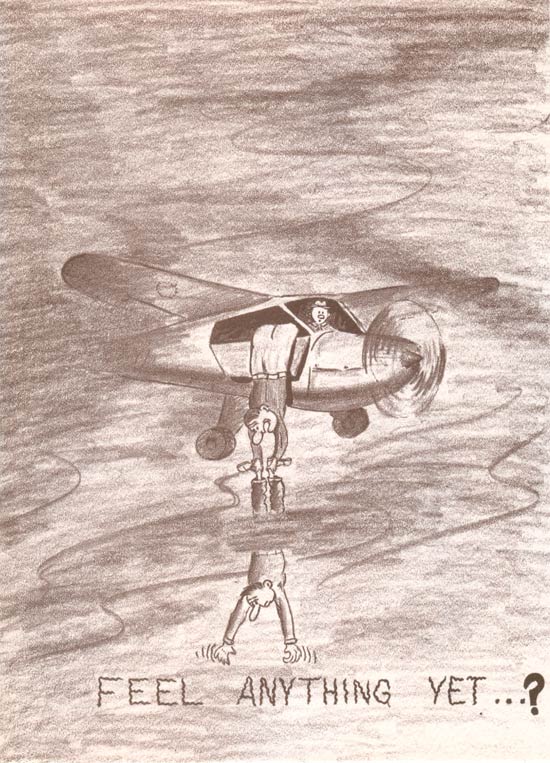 |
Below, the inside of the same card. Compare this opened card with IMAGE 1, above. It appears a window air conditioning unit was added at center right. The aerial 'ground sensor' dangles outside the window, left.
Circa 1940s Tulsa Municipal Airport Christmas Greeting Card, Interior
 |
---o0o---
Now for more FUN! Below is a choice table that lets you download high-resolution images of the photos above. You can easily spend many hours with this one series of photographs. Click on the image numbers in the first column at left to begin the downloads. How many other people and aircraft can you identify in the six photographs? If you find some I haven't flagged, and there are many, please let me KNOW.
High-Resolution Views of the Tulsa Municipal Airport, Manager's Office Interior, ca. November, 1944
| IMAGE NO. |
ORIENTATION |
PARTICULARS |
| 1 (2.5MB) |
Anchor point. |
Personalized propeller clock; Walter Beech, upper left; humidor; radio. |
| 2 (2.5MB) |
Right, 60 deg. from anchor. |
Clarence Tinker, center left; Wiley Post/"Winnie Mae" over door. |
| 3 (2.5MB) |
Right, front of office. |
Eddie Cantor; Hawks' book; Larry Fritz; Jack Frye. |
| 4 (2.6MB) |
180 deg. from anchor. |
Propeller clock; airplane recognition models. |
| 5 (2.5MB) |
Left, front of office. |
James Doolittle, Will Rogers, Charles Lindbergh. |
| 6 (2.5MB) |
Left, rear of office. |
Airport founders; Ruth Nichols. |
You might want to compare these images with the high-resolution photo of the aviator's lounge at the Pioneer Hotel, available here in the C. Burton Cosgrove, Jr. Photograph and Document Collection.
---o0o---
UPLOADED: 02/11/06 REVISED: 10/21/06, 03/06/08, 04/19/08, 05/02/08, 12/04/08, 12/25/08, 05/15/16, 12/30/22
|

